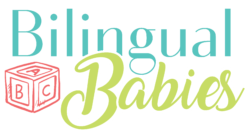A few weeks ago, my daughter looked at me, pointed at the water cup on the table and said “Mama, agua please!” Actually it sounded a bit more like “Mama, aua pees” but the message was clear. She wanted the water on the table in front of her. This got me thinking about this phenomenon called “code-switching”.
What is code-switching?
Code-switching (or code-mixing) means that a speaker alternates or “switches” between different languages (i.e., “codes”) in a single utterance or conversation. Code-switching can happen at different levels of language such as in these German-English-Spanish examples:
- The sound (phonological) level
-
- mop-eando, encourag-en
- The grammatical (syntactic or morphological) level
-
- Ich tu das hier in the bucket. (I put this in the bucket here)
- Ich hab’ das gewatcht (I watched that.)
- The word (semantic) level
-
- “Mama, agua please!” (Mama, water please!)
Is code-switching normal?
Yes, code-switching is completely normal. Basically, anybody who knows more than one language can and oftentimes does code-switch: children and adults alike. Some people code-switch depending on where they are or with whom they are speaking. Personally, I code-switch quite a bit when I speak with people who know both English and German. If we think about it, it’s actually something quite remarkable because it allows bilinguals to draw upon their entire repertoire of language—not just on one language.
However, for a long time, code-switching had a negative reputation. People thought that it was a sign of children being confused with multiple languages and that they were not able to separate the languages (Genesee, 2008). Some people regarded it as a sign of incompetence or even a disability (see e.g., Espinosa, 2010; Genesee et al., 2004). But, just looking at the three examples above provides contrasting evidence—evidence that shows that code-switching is in fact a great competence!
If we look at the three examples, we can see that when children code-switch, they do not violate the grammatical rules of the languages. For example, at the word level, my daughter switched after each word or semantic unit (Mama, agua please!). In other words, we have three different languages in one sentence, but the sentence is grammatically correct! In the case of ge-watch-t, the grammatical boundaries or rules for building the past tense in German are in tact. So the English watch was placed perfectly fine in-between the two German parts of the verb. Also grammatically correct! This is quite remarkable and shows that children keep the languages separate when they code-switch (Genesee et al., 2004; Meisel, 1994). Research has even shown that the brains of unborn babies distinguish and separate between two languages (Byers-Heinlein et al., 2010)!
How can I as a parent or teacher deal with code-switching?
As parents or teachers we sometimes get worried and take code-switching as a sign that a child will not speak a language (oftentimes the minority language) properly. But I think that worry is rooted in that old, but still quite common misconception that code-switching is something bad that needs to be corrected. I think the main message from research is: accept it! Even expect bilingual children to code-switch because it happens all the time.
In addition to accepting it, we can also use the instances of code-switching to provide support for a child’s bilingual language development. For example, we can listen carefully when a child code-switches to see if they might lack certain words in a language. By listening carefully, we can learn a whole lot about a child’s language and why she code-switches. We can then support the language development by providing strong monolingual language models. For example, when Ella says things like Mama, agua please!, I try to response in German along the following lines Möchtest du Wasser? or Ah, du möchtest Wasser? Also, I try to sneak in more questions to keep the interaction and conversation going.
Main takeaways for parents and teachers:
Code-switching …
- is normal and very common
- should not be regarded as something negative or something that needs to be corrected
- shows the cognitive and communicative competence of a child
As a parent or teacher …
- try to listen carefully where, when, and how your child code-switches
- provide a strong monolingual language model
- keep the conversation going to encourage more interaction
Code-switching is regarded as something normal and even quite positive because it is a sign communicative competence!
 Further reading:
Further reading:
If you are interested in reading more, here are three suggestions…
- To learn why people code-switch click here.
- A good summary with practical tips for parents and teachers dealing with English-Spanish code-switching click here.
- In the academic/research literature there are a number of different terms and definitions for code-switching, code-mixing, code-alternation, borrowing etc. with minute distinctions between them. For an overview of this rather contested field subsumed under the umbrella term “code-switching” click here.
- References:
- Byers-Heinlein, K., Burns, T. C., & Werker, J. F. (2010). The roots of bilingualism in newborns. Psychological Sciences, 21, 343-348.
- Espinosa, L. (2010). Getting it RIGHT for young children from diverse backgrounds: Applying research to improve practice. New York: Pearson.
- Genesee, F. (2008). Bilingual First Language Acquisition: Evidence from Montreal. Diversité urbaine, 9-26. Retrieved from http://www.psych.mcgill.ca/perpg/fac/genesee/6.pdf.
- Genesee, F., Paradis, J., & Crago, M. B. (2004). Dual language development and disorders: A handbook on bilingualism and second language learning. Baltimore, MD: Paul Brooks Publishing.
- Meisel, J. (1994). Code-switching in young bilingual children: The acquisition of grammatical constraints. Studies in Second Language Acquisition, 16(4), 413-439.


5 comments
hallo,Veronika, very informative post!
My brothers and I would code-switch all the time when we were younger, never with three languages through. That is quite an impressive feat!
Many thanks! You probably still codeswitch as an adult from time to time, right? Since I moved to the U.S., I caught myself codeswitching between German and English with my sister at times too.
Hi Veronika,
I found this article charming. I am Mexican and my husband is German, we are both fluent in Spanish, English & German, and we do tend to Code Switch a lot at home. As we have a bay now, we try to stick to one person one language, but is really hard as we both work all day in English. To make matters crazier our baby goes to the Creche where everyone speaks French (Swiss Romande), so I do get a little worried about how the little boy is going to get together his influences. It is great to read your blog and hear some real (and well researched) exmples. Thank you for sharing,
Lucy
Many thanks, Lucy! I totally feel you. Sometimes it can be very hard to switch and stick to one language. I also have to remind myself here and there to stick with German and be consistent when I speak English at work all day and with my husband.
All the best to you!
Veronika